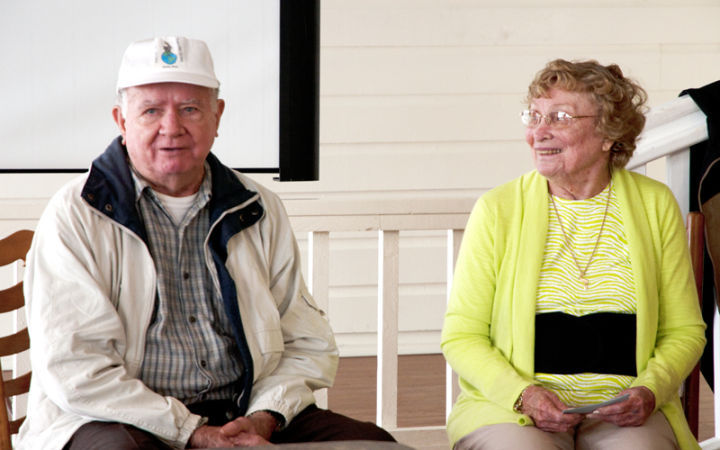
SEBASTIAN — On the 150th birthday of Pelican Island National Wildlife Refuge’s first warden, celebrated at Fisherman’s Landing in Sebastian Thursday, residents got a glimpse into the pioneering lifestyle of the German immigrant who became deeply rooted on the banks of the Indian River Lagoon, and unknowingly started a nationwide trend of wildlife conservation.
{{tncms-asset app=”editorial” id=”6ea85678-7970-11e3-9ca7-001a4bcf6878″}}
“It’s a privilege and honor to carry on with Paul Kroegel’s legacy,” said Kevin Lowry, Visitor Services Manager of the Department of the Interior, U.S. Fish and Wildlife Service. “For one man to protect a tiny 5-acre island that he didn’t even own was a selfless act.”
The pioneer’s life was by no stretch a glamorous one. It was full of hard work just to stay alive. Even so, local homesteader Paul Kroegel not only thought about his family’s well-being but the brown pelicans nesting across the Indian River from his property in Sebastian in the late 1880s.
Kroegel’s impact on American conservation was celebrated at the event offering a snapshot of his life and Sebastian’s heritage, with cultural displays and demonstrations. People sampled traditional pioneer foods such as swamp cabbage, hearts of palm salad, oysters, clams and honey, and sun-brewed iced tea.
Duck decoy carvers, bee keepers, wool spinners, boat builders, and much more demonstrated the day in the life of a traditional pioneer. There were bird programs, including the release of two brown pelicans back into the wild after being rehabilitated by the Bush Wildlife Sanctuary.
“We tend to forget how difficult life was then,” Lowry said. “It was backbreaking work. There was no mosquito control or air conditioning, and it was a jungle setting where they had to clear land to put up a home. It took a lot of time to make food.”
On hand to reminisce about memories of their grandfather were Douglas Paul Kroegel, of Tampa, and Janice Kroegel-Timinsky, as well as other relatives.
“He was a very quiet man and he loved the pelicans,” said Kroegel, 84. “If any other boat came close to the pelicans, the birds would take off. But when he’d pull up to them in his boat, they’d stay and let him pet them.”
Paul Kroegel lived from 1864 to 1948. After his mother died in their hometown of Chemnitz, Germany, Kroegel, his father and brother came to Florida by way of New York and Chicago. He was 17 when they settled on the banks of the Indian River, an area rich in bird life. The family settled on a home they built on an Ais Indian shell mount on the west bank of the river. The house, which is still standing, is located across from Pelican Island, the last rookery for brown pelicans on the east coast of the state.
Kroegel took it upon himself to deter hunters who were slaughtering brown pelicans for their feathers, which were in high demand in the fashion industry at that time.
He had an effective way of doing so.
“He’d go out on his boat with a double barrel shotgun to protect the birds,” said Maury Eastwick, biological technician at the refuge. “He was their guardian saying, ‘Hey, don’t!’”
The State of Florida in 1901 passed legislation to protect non-game birds, and the Florida Audubon Society hired four wildlife wardens to enforce the new law. Kroegel was one of them, and his territory was Pelican Island.
Assisted by Frank Chapman, a prominent figure in the Audubon Society and American Ornithologists’ Union, Kroegel was instrumental in persuading President Theodore Roosevelt to sign an executive order on March 14, 1903, to protect Pelican Island as a preserve and breeding grounds for native birds.
It was the first of what eventually became the National Wildlife Refuge System. There are currently 560 refuges in the country.
Parks are established for people. Refuges are for wildlife, Eastwick explained. There were some 10,000 brown pelicans visiting the Pelican Island refuge in the early 1900s; there are currently a few hundred.
This in part can be attributed to habitat loss and human population growth.
In the beginning of the 20th century, Pelican Island consisted of 5 ½ acres and shrank to 2.8 at one point before the refuge implemented a restoration project. The project involved building oyster reefs to protect the land from erosion caused by waves created by boats, and planting native plants such as red mangroves to protect the island.
The island now consists of 3.2 acres.
The refuge has expanded to cover not only Pelican Island but over 5,400 acres on the barrier island and surrounding waters. The entrance to the refuge is located on U.S. Highway A1A and north Historic Jungle Trail, about four miles from Wabasso Beach Road, or CR510.
“He’s the one who stood up to make a difference,” said City of Sebastian Mayor Bob McPartlan, who announced a proclamation for Paul Kroegel Day. “He saw the slaughtering of pelicans and got the attention of Roosevelt, which started a whole history of saving wildlife.”
Also attending the event was Niles-Simmons Hegensheidt, who came all the way from Kroegel’s hometown of Chemnitz for the event, and to offer a little insight on the pioneer’s birth place. He described it “as the cradle of machine-building” in Germany where they made tools, steam engines, motors and other things for the automotive industry.
Next to Fisherman’s Landing at Crab-E-Bill’s Seafood Market, people viewed a documentary entitled, America’s Gatekeeper: Story of Paul Kroegel, and listened to the Kroegel’s grandchildren reminisce.
Summing up the importance of the late pioneer and conservationist, Eastwick said, “He embodies a vision of conservation and willingness to do anything to protect wildlife.”
Pelican Island provides habitat for over 30 species of birds. Typically, several thousand birds roost on the island nightly during the migratory season from November to March.



